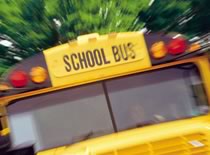Update on School (K – 12) and Childcare Facilities: Interim CDC Guidance in Response to Human Infections with the Novel Influenza A (H1N1) Virus
May 5, 2009, 6:45 PM EDT
Background
 This document provides updated interim guidance for schools and childcare facilities regarding the prevention of the spread of novel influenza A (H1N1) virus.
This document provides updated interim guidance for schools and childcare facilities regarding the prevention of the spread of novel influenza A (H1N1) virus.
Initial cases of novel influenza A (H1N1) in the United States included school-aged students and were associated with travel to Mexico and school-based outbreaks. Early information from Mexico indicated that many previously healthy young adults were hospitalized with rapidly progressive pneumonia, frequently resulting in respiratory failure requiring mechanical ventilation and death.
Based on this initial information, CDC recommended consideration of school closure as an option to lessen the risk of infection with this novel influenza virus in order to protect students, staff, parents and other caregivers from a potentially severe disease as well as limit spread into the community.
New information on disease severity and the extent of community spread warrant revision of the school closure guidance. As of May 4, 2009, more than 1000 confirmed or probable cases of novel influenza A (H1N1) have been reported from 44 states, with numerous disease clusters, indicating spread within communities that makes individual school closure less effective as a control measure. Most U.S. cases have not been severe and are comparable in severity to seasonal influenza. CDC and local and state health officials will continue to closely monitor the severity and spread of this novel H1N1 influenza outbreak.
At this time, CDC recommends the primary means to reduce spread of influenza in schools is to focus on early identification of ill students and staff, staying home when ill, and good cough and hand hygiene etiquette. Decisions about school closure should be at the discretion of local authorities based on local considerations, including public concern and the impact of school absenteeism and staffing shortages.
Recommendations
- School closure is not advised for a suspected or confirmed case of novel influenza A (H1N1) and, in general, is not advised unless there is a magnitude of faculty or student absenteeism that interferes with the school’s ability to function.
- Schools that were closed based on previous interim CDC guidance related to this outbreak may reopen.
- Students, faculty or staff with influenza-like illness (fever with a cough or sore throat) should stay home and not attend school or go into the community except to seek medical care for at least 7 days even if symptoms resolve sooner.
- Students, faculty and staff who are still sick 7 days after they become ill should continue to stay home from school until at least 24 hours after symptoms have resolved.
- Students, faculty and staff who appear to have an influenza-like illness at arrival or become ill during the school day should be isolated promptly in a room separate from other students and sent home.
- Parents and guardians should monitor their school-aged children, and faculty and staff should self-monitor every morning for symptoms of influenza-like illness.
- Ill students should not attend alternative child care or congregate in settings other than school.
- School administrators should communicate regularly with local public health officials to obtain guidance about reporting of influenza-like illnesses in the school.
- Schools can help serve as a focus for educational activities aimed at promoting ways to reduce the spread of influenza, including hand hygiene and cough etiquette.
- Students, faculty and staff should stringently follow sanitary measures to reduce the spread of influenza, including covering their nose and mouth with a tissue when coughing or sneezing (or coughing or sneezing into their sleeve if a tissue isn’t available), frequently washing hands with soap and water, or using hand sanitizer if hand washing with soap and water is not possible.
Further guidance can be found in:
- Questions and Answers About Novel H1N1 Flu
- What to Do If You Get Flu-Like Symptoms
- Interim Guidance for H1N1 Flu: Taking Care of a Sick Person in Your Home
- Links to non-federal organizations are provided solely as a service to our users. These links do not constitute an endorsement of these organizations or their programs by CDC or the federal government, and none should be inferred. CDC is not responsible for the content of the individual organization Web pages found at these links.
Get email updates
To receive daily email updates about this site, enter your email address:
Contact Us:
- Centers for Disease Control and Prevention
1600 Clifton Rd
Atlanta, GA 30333 - 800-CDC-INFO
(800-232-4636)
TTY: (888) 232-6348
24 Hours/Every Day - cdcinfo@cdc.gov


